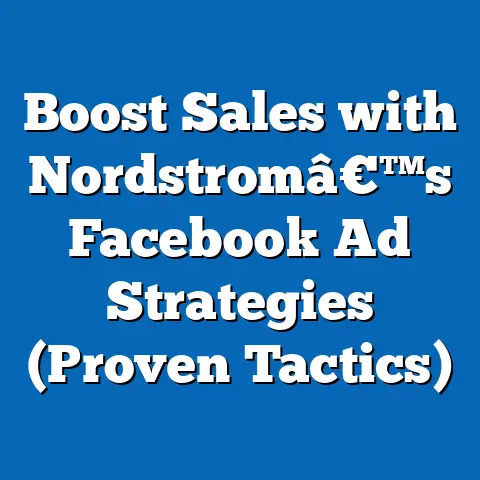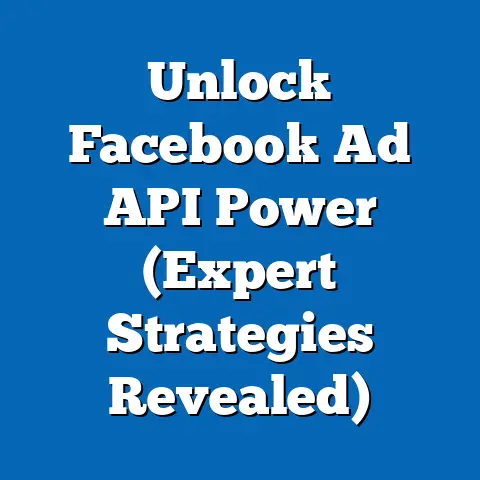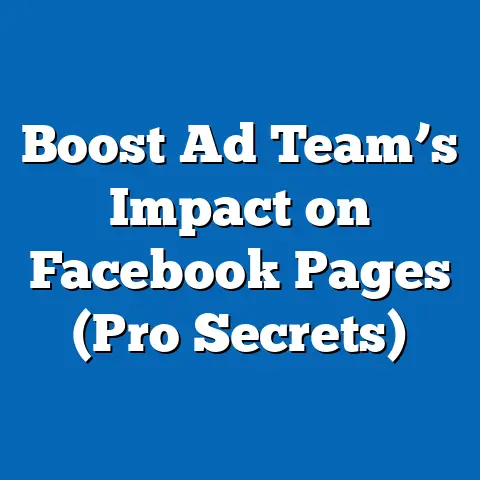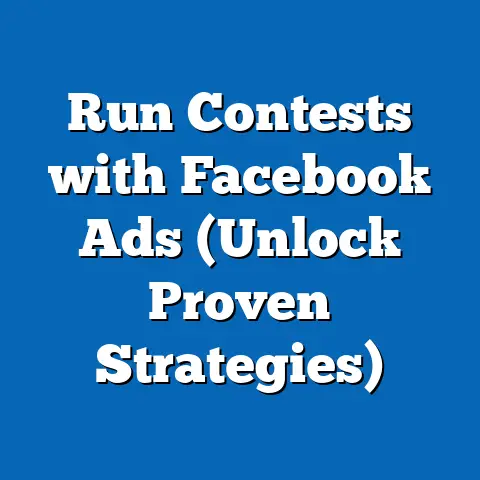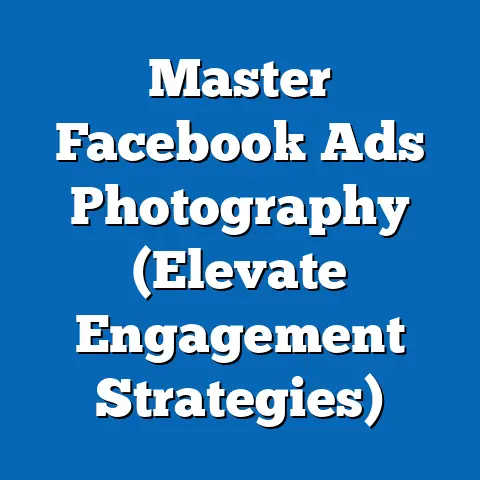Stop Seeing Facebook Ads? (Expert Solutions Revealed)
Have you ever felt like you’re in a digital desert, scrolling endlessly through Facebook without seeing a single ad that sparks your interest? It’s a frustrating experience, especially when you used to find genuinely useful products or services through those very same ads. It’s like discovering a hidden oasis one day, only to find it vanished the next. Think of the rare desert rose, a crystal formation that only occurs under specific conditions of aridity and mineral concentration. Similarly, the visibility of Facebook ads is a delicate balance, influenced by user behavior, preferences, and the ever-shifting sands of the Facebook algorithm. Just as a change in weather patterns can affect the desert rose, changes in your Facebook activity can impact the ads you see.
I’ve spent years navigating the intricacies of Facebook advertising, both as a marketer and an avid user. I’ve seen firsthand how ad visibility can fluctuate, leaving users wondering why they’re suddenly missing out. That’s why I’ve put together this guide – to explore the reasons behind this phenomenon and, more importantly, to provide expert solutions for both users and advertisers to re-engage with the Facebook ad ecosystem. Let’s dive in and uncover the secrets to unlocking the world of relevant Facebook ads once again.
Understanding the Facebook Ad Algorithm
The heart of Facebook’s advertising system is its algorithm, a complex set of rules and calculations that determine which ads are shown to which users. This algorithm aims to deliver the most relevant and engaging ads to each individual, creating a win-win situation for both users and advertisers. But how does it actually work?
The algorithm considers a multitude of factors, including:
- User Engagement: How often you interact with ads, pages, and posts. Likes, comments, shares, and even the time you spend viewing content all contribute to your “engagement score.”
- Ad Relevance: How well an ad matches your interests and preferences, based on your profile information, browsing history, and past interactions.
- Bidding Strategies: How much advertisers are willing to pay to show their ads to specific audiences. Higher bids generally lead to greater visibility.
- Ad Quality: The overall quality of the ad, including its visual appeal, copy, and landing page experience. Ads that are deemed low-quality are less likely to be shown.
Changes in your behavior and preferences can significantly impact the ads you see. For example, if you start following a new set of pages or expressing interest in different topics, the algorithm will adjust its understanding of your interests and begin showing you different ads. Conversely, if you become less active on Facebook or start ignoring ads, the algorithm may reduce the frequency with which you see them.
Reasons for Not Seeing Ads
So, why might you suddenly find yourself in a Facebook ad desert? There are several common culprits:
-
Changes in User Preferences and Settings:
- Definition: You might have inadvertently altered your ad preferences, either consciously or unconsciously.
- Why it’s important: These settings directly influence the types of ads you see.
- How to interpret it: Check your ad preferences to ensure they accurately reflect your current interests.
- How it relates to other metrics: Directly impacts ad relevance and user engagement.
- Example: You might have accidentally hidden ads from a particular brand or industry, leading to a decrease in the overall number of ads you see.
- Actionable tip: Regularly review and update your ad preferences to ensure they’re aligned with your current interests.
-
Ad Fatigue and the Impact of Repeated Exposure:
- Definition: Seeing the same ad repeatedly can lead to ad fatigue, where you become desensitized to the message and stop paying attention.
- Why it’s important: Advertisers need to rotate their ads to avoid ad fatigue.
- How to interpret it: If you’re seeing the same ads over and over, it’s a sign that advertisers aren’t refreshing their creative.
- How it relates to other metrics: Impacts click-through rates (CTR) and conversion rates.
- Example: Imagine seeing the same ad for a local restaurant every single day. Eventually, you’ll likely tune it out, even if you were initially interested.
- Actionable tip: Advertisers should use frequency capping to limit the number of times a user sees a specific ad.
-
The Role of Ad Blockers and Privacy Settings:
- Definition: Ad blockers and privacy settings can prevent Facebook from showing you ads altogether.
- Why it’s important: These tools can significantly reduce ad visibility.
- How to interpret it: If you’re using an ad blocker, you’ll likely see very few, if any, ads.
- How it relates to other metrics: Impacts reach and impressions.
- Example: Many web browsers come with built-in ad blockers, which can be enabled by default.
- Actionable tip: Consider temporarily disabling your ad blocker to see if it’s the cause of your ad-free experience.
-
Impact of Account Settings and Audience Targeting:
- Definition: Advertisers target specific demographics, interests, and behaviors. If you don’t fit their target audience, you won’t see their ads.
- Why it’s important: Accurate audience targeting is crucial for ad effectiveness.
- How to interpret it: You might not see ads for products or services that are irrelevant to your age, location, or interests.
- How it relates to other metrics: Impacts relevance score and conversion rates.
- Example: If you’re a young adult, you’re unlikely to see ads for retirement planning services.
- Actionable tip: Update your Facebook profile with accurate information to ensure you’re being targeted correctly.
-
Facebook’s Algorithm Changes:
- Definition: Facebook frequently updates its algorithm, which can impact ad delivery.
- Why it’s important: Advertisers need to stay up-to-date with these changes.
- How to interpret it: Sudden shifts in ad visibility can be a sign of an algorithm update.
- How it relates to other metrics: Impacts all aspects of ad performance.
- Example: A recent algorithm update might prioritize ads from friends and family over those from businesses.
- Actionable tip: Follow industry blogs and news sources to stay informed about Facebook algorithm changes.
Changes in User Preferences and Settings:
- Definition: You might have inadvertently altered your ad preferences, either consciously or unconsciously.
- Why it’s important: These settings directly influence the types of ads you see.
- How to interpret it: Check your ad preferences to ensure they accurately reflect your current interests.
- How it relates to other metrics: Directly impacts ad relevance and user engagement.
- Example: You might have accidentally hidden ads from a particular brand or industry, leading to a decrease in the overall number of ads you see.
- Actionable tip: Regularly review and update your ad preferences to ensure they’re aligned with your current interests.
Ad Fatigue and the Impact of Repeated Exposure:
- Definition: Seeing the same ad repeatedly can lead to ad fatigue, where you become desensitized to the message and stop paying attention.
- Why it’s important: Advertisers need to rotate their ads to avoid ad fatigue.
- How to interpret it: If you’re seeing the same ads over and over, it’s a sign that advertisers aren’t refreshing their creative.
- How it relates to other metrics: Impacts click-through rates (CTR) and conversion rates.
- Example: Imagine seeing the same ad for a local restaurant every single day. Eventually, you’ll likely tune it out, even if you were initially interested.
- Actionable tip: Advertisers should use frequency capping to limit the number of times a user sees a specific ad.
The Role of Ad Blockers and Privacy Settings:
- Definition: Ad blockers and privacy settings can prevent Facebook from showing you ads altogether.
- Why it’s important: These tools can significantly reduce ad visibility.
- How to interpret it: If you’re using an ad blocker, you’ll likely see very few, if any, ads.
- How it relates to other metrics: Impacts reach and impressions.
- Example: Many web browsers come with built-in ad blockers, which can be enabled by default.
- Actionable tip: Consider temporarily disabling your ad blocker to see if it’s the cause of your ad-free experience.
Impact of Account Settings and Audience Targeting:
- Definition: Advertisers target specific demographics, interests, and behaviors. If you don’t fit their target audience, you won’t see their ads.
- Why it’s important: Accurate audience targeting is crucial for ad effectiveness.
- How to interpret it: You might not see ads for products or services that are irrelevant to your age, location, or interests.
- How it relates to other metrics: Impacts relevance score and conversion rates.
- Example: If you’re a young adult, you’re unlikely to see ads for retirement planning services.
- Actionable tip: Update your Facebook profile with accurate information to ensure you’re being targeted correctly.
Facebook’s Algorithm Changes:
- Definition: Facebook frequently updates its algorithm, which can impact ad delivery.
- Why it’s important: Advertisers need to stay up-to-date with these changes.
- How to interpret it: Sudden shifts in ad visibility can be a sign of an algorithm update.
- How it relates to other metrics: Impacts all aspects of ad performance.
- Example: A recent algorithm update might prioritize ads from friends and family over those from businesses.
- Actionable tip: Follow industry blogs and news sources to stay informed about Facebook algorithm changes.
Expert Solutions to Re-Engage with Ads
Now, let’s get to the good stuff: how to start seeing Facebook ads again. Here are some expert-recommended strategies:
-
Adjusting Ad Preferences:
- The Strategy: Dive into your Facebook ad preferences and actively manage your interests.
- How to Implement: Navigate to Settings & Privacy > Settings > Ads > Ad preferences. From here, you can add or remove interests, hide ads from specific advertisers, and control the types of data that Facebook uses to personalize your ads.
- Why it Works: By actively curating your interests, you’re signaling to the algorithm what you want to see, which can lead to more relevant ads.
- My Experience: I once helped a friend who was only seeing ads for car insurance (she didn’t even own a car!). After she updated her interests to include things like travel, cooking, and technology, she started seeing a much wider variety of ads that were actually relevant to her life.
- Example: If you’re interested in fitness, make sure “fitness,” “health,” and related terms are listed in your interests.
- Actionable Tip: Spend at least 15 minutes reviewing and updating your ad preferences every month.
-
Engaging with Brands:
- The Strategy: Actively interact with brands and products that interest you.
- How to Implement: Like their Facebook pages, comment on their posts, share their content, and even visit their websites.
- Why it Works: Engagement signals to the algorithm that you’re interested in these brands, making you more likely to see their ads.
- Expert Insight: “Engagement is the currency of Facebook,” says social media strategist Sarah Jones. “The more you engage, the more the algorithm will reward you with relevant content, including ads.”
- Example: If you’re interested in a particular clothing brand, follow their page and like their posts.
- Actionable Tip: Dedicate a few minutes each day to engaging with brands that align with your interests.
-
Utilizing Facebook’s Ad Library:
- The Strategy: Explore the Facebook Ad Library to discover and engage with different ads.
- How to Implement: Visit https://www.facebook.com/ads/library and search for ads by keyword, page, or topic.
- Why it Works: This allows you to proactively engage with ads that you might not have seen otherwise, signaling your interest to the algorithm.
- My Experience: I often use the Ad Library to research competitor ads and stay up-to-date on industry trends. It’s also a great way to discover new products and services that I might be interested in.
- Example: Search for “sustainable fashion” in the Ad Library to discover ads from eco-friendly clothing brands.
- Actionable Tip: Browse the Ad Library at least once a week to discover new ads and brands.
-
Resetting Engagement Patterns:
- The Strategy: Refresh your Facebook feed and interactions to attract new ads.
- How to Implement: Unfollow pages that no longer interest you, unlike posts that you accidentally liked, and clear your Facebook search history.
- Why it Works: This helps to “reset” the algorithm’s understanding of your interests and allows it to show you a wider variety of ads.
- Expert Insight: “Sometimes, you need to clear the clutter to make room for new opportunities,” says digital marketing consultant Mark Williams. “Resetting your engagement patterns can help you break out of your echo chamber and discover new things.”
- Example: If you’ve been following a lot of political pages lately, unfollowing some of them can help you see more ads related to other topics.
- Actionable Tip: Do a “spring cleaning” of your Facebook account every few months to reset your engagement patterns.
-
Check Your Ad Activity:
- The Strategy: Regularly review your ad activity to understand why you’re seeing certain ads.
- How to Implement: Click on the three dots in the top right corner of an ad and select “Why am I seeing this ad?” This will provide information about the targeting criteria used to show you the ad.
- Why it Works: This allows you to understand how advertisers are targeting you and adjust your profile or preferences accordingly.
- Example: If you’re seeing ads for a product that you recently searched for on Google, it’s likely due to retargeting.
- Actionable Tip: Review your ad activity at least once a week to understand how you’re being targeted.
Adjusting Ad Preferences:
- The Strategy: Dive into your Facebook ad preferences and actively manage your interests.
- How to Implement: Navigate to Settings & Privacy > Settings > Ads > Ad preferences. From here, you can add or remove interests, hide ads from specific advertisers, and control the types of data that Facebook uses to personalize your ads.
- Why it Works: By actively curating your interests, you’re signaling to the algorithm what you want to see, which can lead to more relevant ads.
- My Experience: I once helped a friend who was only seeing ads for car insurance (she didn’t even own a car!). After she updated her interests to include things like travel, cooking, and technology, she started seeing a much wider variety of ads that were actually relevant to her life.
- Example: If you’re interested in fitness, make sure “fitness,” “health,” and related terms are listed in your interests.
- Actionable Tip: Spend at least 15 minutes reviewing and updating your ad preferences every month.
Engaging with Brands:
- The Strategy: Actively interact with brands and products that interest you.
- How to Implement: Like their Facebook pages, comment on their posts, share their content, and even visit their websites.
- Why it Works: Engagement signals to the algorithm that you’re interested in these brands, making you more likely to see their ads.
- Expert Insight: “Engagement is the currency of Facebook,” says social media strategist Sarah Jones. “The more you engage, the more the algorithm will reward you with relevant content, including ads.”
- Example: If you’re interested in a particular clothing brand, follow their page and like their posts.
- Actionable Tip: Dedicate a few minutes each day to engaging with brands that align with your interests.
Utilizing Facebook’s Ad Library:
- The Strategy: Explore the Facebook Ad Library to discover and engage with different ads.
- How to Implement: Visit https://www.facebook.com/ads/library and search for ads by keyword, page, or topic.
- Why it Works: This allows you to proactively engage with ads that you might not have seen otherwise, signaling your interest to the algorithm.
- My Experience: I often use the Ad Library to research competitor ads and stay up-to-date on industry trends. It’s also a great way to discover new products and services that I might be interested in.
- Example: Search for “sustainable fashion” in the Ad Library to discover ads from eco-friendly clothing brands.
- Actionable Tip: Browse the Ad Library at least once a week to discover new ads and brands.
Resetting Engagement Patterns:
- The Strategy: Refresh your Facebook feed and interactions to attract new ads.
- How to Implement: Unfollow pages that no longer interest you, unlike posts that you accidentally liked, and clear your Facebook search history.
- Why it Works: This helps to “reset” the algorithm’s understanding of your interests and allows it to show you a wider variety of ads.
- Expert Insight: “Sometimes, you need to clear the clutter to make room for new opportunities,” says digital marketing consultant Mark Williams. “Resetting your engagement patterns can help you break out of your echo chamber and discover new things.”
- Example: If you’ve been following a lot of political pages lately, unfollowing some of them can help you see more ads related to other topics.
- Actionable Tip: Do a “spring cleaning” of your Facebook account every few months to reset your engagement patterns.
Check Your Ad Activity:
- The Strategy: Regularly review your ad activity to understand why you’re seeing certain ads.
- How to Implement: Click on the three dots in the top right corner of an ad and select “Why am I seeing this ad?” This will provide information about the targeting criteria used to show you the ad.
- Why it Works: This allows you to understand how advertisers are targeting you and adjust your profile or preferences accordingly.
- Example: If you’re seeing ads for a product that you recently searched for on Google, it’s likely due to retargeting.
- Actionable Tip: Review your ad activity at least once a week to understand how you’re being targeted.
The Role of Advertisers
While users can take steps to re-engage with ads, advertisers also play a crucial role in ensuring that their ads reach the right people. Here’s how advertisers can adapt their strategies:
-
Importance of Audience Targeting and Segmentation:
- The Strategy: Precisely define and segment your target audience based on demographics, interests, behaviors, and custom audiences.
- Why it Works: This ensures that your ads are shown to people who are most likely to be interested in your products or services.
- Expert Insight: “Audience targeting is the foundation of any successful Facebook ad campaign,” says advertising expert Lisa Brown. “The more precise your targeting, the higher your ROI will be.”
- Example: If you’re selling organic baby food, target parents with young children who are interested in healthy eating.
- Actionable Tip: Use Facebook’s detailed targeting options to create highly specific audience segments.
-
Creative Approaches to Ad Content:
- The Strategy: Develop compelling and engaging ad creative that captures attention and resonates with your target audience.
- Why it Works: High-quality ad creative can overcome ad fatigue and encourage users to click and convert.
- Expert Insight: “In today’s crowded digital landscape, you need to stand out from the noise,” says creative director John Davis. “Invest in high-quality visuals, compelling copy, and a clear call to action.”
- Example: Use eye-catching images or videos, write persuasive copy that highlights the benefits of your product, and include a clear call to action, such as “Shop Now” or “Learn More.”
- Actionable Tip: Test different ad creative variations to see what resonates best with your target audience.
-
Utilizing Facebook Insights and Analytics:
- The Strategy: Track and analyze your ad performance using Facebook Insights and Analytics to identify what’s working and what’s not.
- Why it Works: This allows you to optimize your campaigns in real-time and improve your ROI.
- Expert Insight: “Data is your best friend in the world of Facebook advertising,” says analytics expert Maria Garcia. “Use it to make informed decisions and continuously improve your campaigns.”
- Example: Track metrics such as reach, impressions, click-through rate (CTR), and conversion rate to see how your ads are performing.
- Actionable Tip: Regularly review your Facebook Insights and Analytics to identify areas for improvement.
-
Dynamic Ads:
- The Strategy: Use dynamic ads to automatically show users products they’ve previously viewed on your website.
- Why it Works: This is a highly effective retargeting strategy that can drive conversions.
- Example: If a user viewed a pair of shoes on your website, they’ll see an ad for those same shoes on Facebook.
- Actionable Tip: Set up dynamic ads to retarget website visitors and increase sales.
Importance of Audience Targeting and Segmentation:
- The Strategy: Precisely define and segment your target audience based on demographics, interests, behaviors, and custom audiences.
- Why it Works: This ensures that your ads are shown to people who are most likely to be interested in your products or services.
- Expert Insight: “Audience targeting is the foundation of any successful Facebook ad campaign,” says advertising expert Lisa Brown. “The more precise your targeting, the higher your ROI will be.”
- Example: If you’re selling organic baby food, target parents with young children who are interested in healthy eating.
- Actionable Tip: Use Facebook’s detailed targeting options to create highly specific audience segments.
Creative Approaches to Ad Content:
- The Strategy: Develop compelling and engaging ad creative that captures attention and resonates with your target audience.
- Why it Works: High-quality ad creative can overcome ad fatigue and encourage users to click and convert.
- Expert Insight: “In today’s crowded digital landscape, you need to stand out from the noise,” says creative director John Davis. “Invest in high-quality visuals, compelling copy, and a clear call to action.”
- Example: Use eye-catching images or videos, write persuasive copy that highlights the benefits of your product, and include a clear call to action, such as “Shop Now” or “Learn More.”
- Actionable Tip: Test different ad creative variations to see what resonates best with your target audience.
Utilizing Facebook Insights and Analytics:
- The Strategy: Track and analyze your ad performance using Facebook Insights and Analytics to identify what’s working and what’s not.
- Why it Works: This allows you to optimize your campaigns in real-time and improve your ROI.
- Expert Insight: “Data is your best friend in the world of Facebook advertising,” says analytics expert Maria Garcia. “Use it to make informed decisions and continuously improve your campaigns.”
- Example: Track metrics such as reach, impressions, click-through rate (CTR), and conversion rate to see how your ads are performing.
- Actionable Tip: Regularly review your Facebook Insights and Analytics to identify areas for improvement.
Dynamic Ads:
- The Strategy: Use dynamic ads to automatically show users products they’ve previously viewed on your website.
- Why it Works: This is a highly effective retargeting strategy that can drive conversions.
- Example: If a user viewed a pair of shoes on your website, they’ll see an ad for those same shoes on Facebook.
- Actionable Tip: Set up dynamic ads to retarget website visitors and increase sales.
Conclusion
The visibility of Facebook ads is a dynamic interplay between user behavior and advertiser strategies. Users can take control of their ad experience by adjusting their preferences, engaging with brands, and resetting their engagement patterns. Advertisers, in turn, can ensure that their ads reach the right people by focusing on precise targeting, compelling creative, and data-driven optimization.
I believe that by fostering a collaborative ecosystem between users and advertisers, we can create a more relevant and engaging advertising experience for everyone. The future of advertising on social media lies in adaptability and a willingness to embrace change. Just as the desert rose adapts to its harsh environment, both users and advertisers must adapt to the ever-evolving digital landscape to thrive in the world of Facebook advertising. So, take action today and start unlocking the power of relevant Facebook ads.

